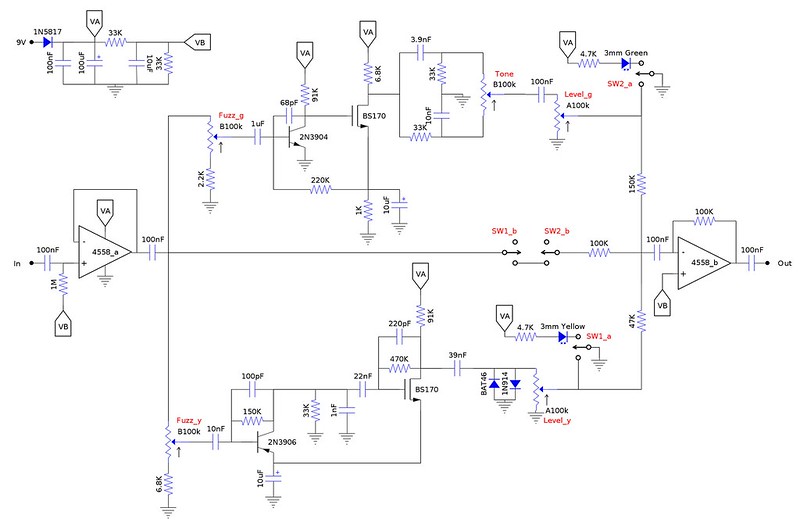Aleph Null
Well-known member
I was reminded of this project when @jessenator posted his build report of the XL Edition, designed for a 1590BB enclosure. I originally built this on vero, but also made a compact 125B layout in addition to the 1590BB version.

The idea came when I was toggling between two different dirt boxes with very different characters and thought to myself, "These would sound great in a mix together if I double tracked guitar with them!" My next thought was, "Why double track when I can just split the signal and run the effects in parallel?!" The result is the Peacock Parallel Fuzz: two distinctly voiced fuzzes that can be run independently or in parallel.

Maybe not as aesthetically pleasing a layout as I normally aspire to, but the 30° knobs informed a lot of the placement choices. In order to get all the knobs equally spaced, I had to use 16mm pots for the green channel and 9mm for the yellow channel.

An input buffer feeds two fuzz circuits which are then mixed by an active mixer at the output. The "bypass" switches really just cut off the clean input when the fuzz is engaged and ground the LED, or ground the fuzz output when the fuzz is off.
The yellow channel is a Harmonic Percolator that has been voiced to be as mid-range focused and percussive as possible. This stock circuit does not like being placed after a buffer. I tested a few different ways to address this including series resistance at the input and a pickup emulator and found that a mosfet in Q2 behaves much more nicely than a BJT and doesn't require any of these other, more involved solutions.
The green channel is a Fuzz Face doing its best Big Muff impression. The feedback resistor has been greatly increased to increase the available saturation. The mosfet in Q2 helps with this as well (and makes the circuit play nice with the input buffer). The tilt eq is voiced like a Ram's Head muff—especially scooped. This leaves room for the yellow channel to poke through when the two fuzzes are used together.
Here' s a demo:
If anyone is interested in building one, I have extra PCBs for both the 125B and 1590BB versions, depending on your shoe size. Just DM me.
Just DM me.

The idea came when I was toggling between two different dirt boxes with very different characters and thought to myself, "These would sound great in a mix together if I double tracked guitar with them!" My next thought was, "Why double track when I can just split the signal and run the effects in parallel?!" The result is the Peacock Parallel Fuzz: two distinctly voiced fuzzes that can be run independently or in parallel.

Maybe not as aesthetically pleasing a layout as I normally aspire to, but the 30° knobs informed a lot of the placement choices. In order to get all the knobs equally spaced, I had to use 16mm pots for the green channel and 9mm for the yellow channel.

An input buffer feeds two fuzz circuits which are then mixed by an active mixer at the output. The "bypass" switches really just cut off the clean input when the fuzz is engaged and ground the LED, or ground the fuzz output when the fuzz is off.
The yellow channel is a Harmonic Percolator that has been voiced to be as mid-range focused and percussive as possible. This stock circuit does not like being placed after a buffer. I tested a few different ways to address this including series resistance at the input and a pickup emulator and found that a mosfet in Q2 behaves much more nicely than a BJT and doesn't require any of these other, more involved solutions.
The green channel is a Fuzz Face doing its best Big Muff impression. The feedback resistor has been greatly increased to increase the available saturation. The mosfet in Q2 helps with this as well (and makes the circuit play nice with the input buffer). The tilt eq is voiced like a Ram's Head muff—especially scooped. This leaves room for the yellow channel to poke through when the two fuzzes are used together.
Here' s a demo:
If anyone is interested in building one, I have extra PCBs for both the 125B and 1590BB versions, depending on your shoe size.

